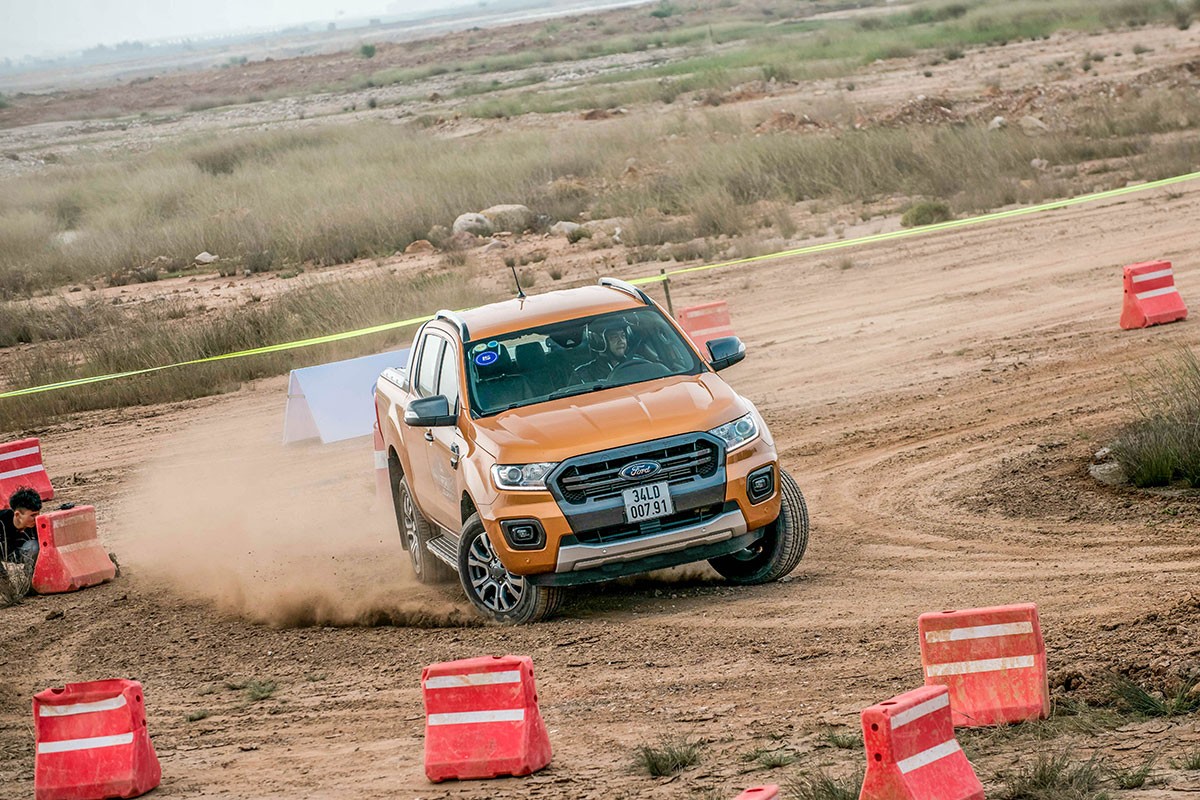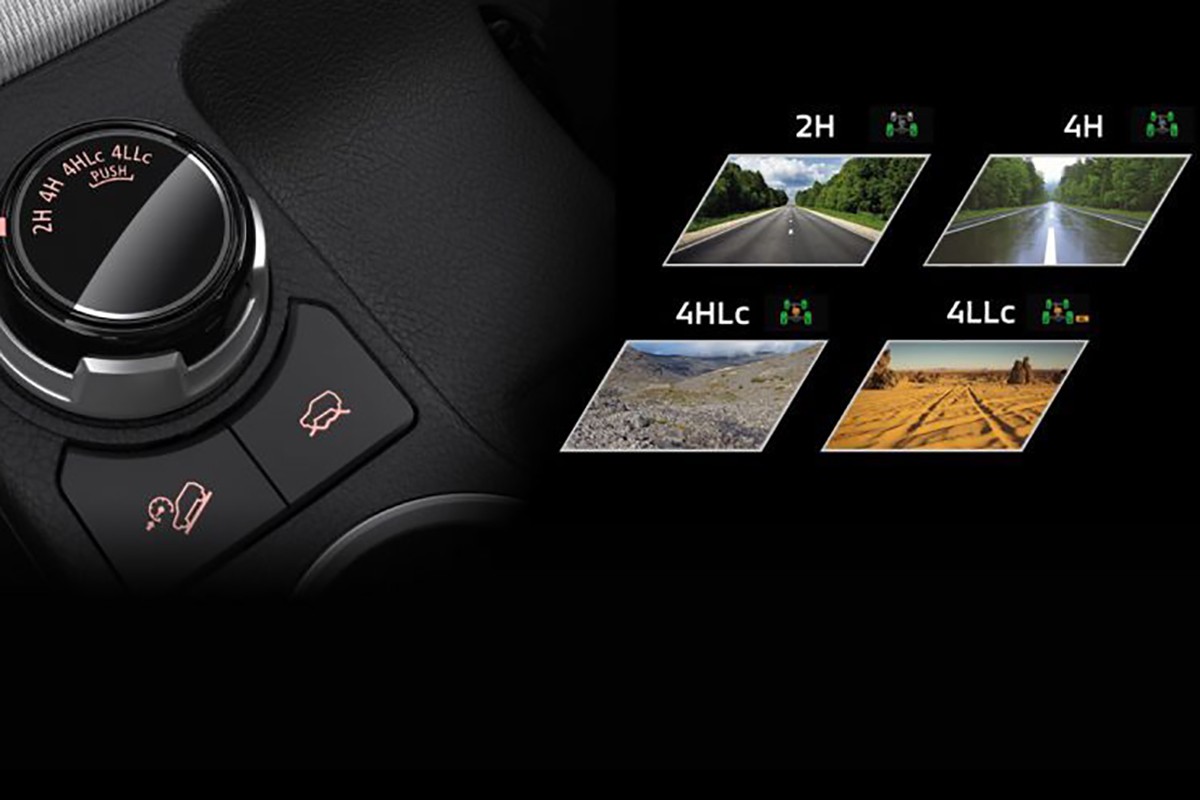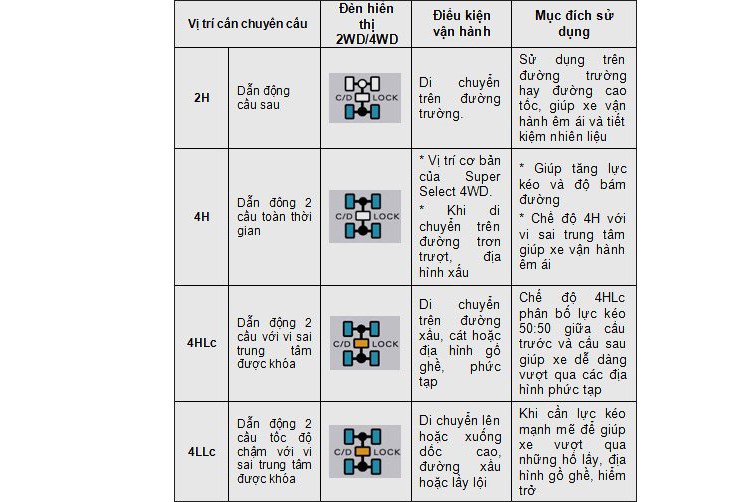Today, pickup trucks are increasingly popular not only for their powerful appearance but also for their superior performance, especially on challenging terrains. One of the factors that differentiates pickup trucks is their 4-wheel drive (4WD) system with flexible transfer case modes. However, not everyone fully understands how to engage 4WD on a pickup truck correctly and safely. This article from the experts at Xe Tải Mỹ Đình will provide a detailed guide to help you master the 4WD system on your pickup truck.
 Ford Ranger Wildtrak pickup truck.
Ford Ranger Wildtrak pickup truck.
How Does the 4-Wheel Drive (4WD) System on a Pickup Truck Work?
The 4-wheel drive (4WD) system on a pickup truck allows power from the engine to be transmitted to all four wheels, instead of just two wheels as in a conventional 2-wheel drive system. This provides greater traction, helping the vehicle overcome slippery, muddy, or hilly terrains with ease. Most current pickup truck models are equipped with a part-time 4WD system, allowing the driver to actively select the drive mode appropriate for the driving conditions.
Common transfer case modes on pickup trucks include 2H, 4H, and 4L, sometimes with additional 4HLc and 4LLc modes on some higher-end models. Understanding the meaning and how to engage 4WD on a pickup truck for each mode is key to maximizing power and ensuring driving safety.
When Do You Need to Engage 4WD on Your Pickup Truck?
Using the appropriate 4WD mode will help your pickup truck operate more efficiently and safely in various situations. Below are some cases where you should engage 4WD on your pickup truck:
- Driving on rough terrain: When driving on dirt roads, rocky surfaces, sand, mud, flooded roads, or hilly roads, engaging 4WD will increase traction, helping the vehicle overcome obstacles more easily and stably.
- Driving on slippery roads: In adverse weather conditions such as heavy rain, icy roads, or snowfall, engaging 4WD helps the vehicle enhance control, reducing the risk of wheel slippage and loss of control.
- Towing or carrying heavy loads: When the vehicle needs to tow a trailer or carry heavy cargo, engaging 4WD will provide additional pulling power, helping the vehicle move more powerfully and stably, especially when starting or climbing hills.
However, it is important to note that engaging 4WD on a pickup truck incorrectly or using it at the wrong time can have negative impacts on the drivetrain and reduce the vehicle’s operating efficiency.
Detailed Guide on How to Engage 4WD on a Pickup Truck (Step-by-Step)
The method to engage 4WD on a pickup truck may vary depending on the specific vehicle model and 4WD system (electronic or mechanical). However, the general process usually includes the following steps:
Identify the Type of 4WD System
Before implementing how to engage 4WD on a pickup truck, you need to identify the type of 4WD system on your vehicle. Currently, there are two common types:
- Electronic rotary knob: Commonly equipped on newer pickup truck models, allowing switching 4WD modes by turning a control knob.
- Mechanical shift lever: Found on older models, engaging 4WD is done through an auxiliary shift lever, requiring mechanical operation.
 Electronic rotary knob for selecting 4WD modes.
Electronic rotary knob for selecting 4WD modes.
Common 4WD Modes and Their Meanings
Understanding the meaning of each 4WD mode is an important step in how to engage 4WD on a pickup truck effectively:
- 2H (2-High): Two-wheel drive mode (usually rear-wheel drive), suitable for driving on flat, dry roads at high speeds. Advantages include fuel efficiency and smooth operation.
- 4H (4-High): High-range four-wheel drive mode, distributing power to all four wheels. Used when driving on slippery roads, gravel roads, or rough roads at moderate speeds (under 60 mph or 100 km/h). You can switch from 2H to 4H while the vehicle is moving at permitted speeds.
- 4L (4-Low): Low-range four-wheel drive mode, generating maximum torque at low speeds. Used when overcoming extremely difficult terrains such as steep inclines, deep mud, or when needing high pulling force to tow heavy objects. To engage or disengage 4L mode, the vehicle needs to be completely stopped, and the gear selector shifted to N (Neutral) for automatic transmissions or clutch pedal depressed for manual transmissions.
- 4HLc (4-High Lock Center Differential) and 4LLc (4-Low Lock Center Differential): Some high-end pickup trucks are equipped with these modes, combining 4H or 4L mode with a center differential lock. This mode helps distribute power more evenly between the front and rear axles, increasing the ability to overcome complex terrains.
Detailed 4WD Engagement and Disengagement Procedure
How to engage 4WD on a pickup truck specifically for each mode is as follows:
- Switching from 2H to 4H: Can be done while the vehicle is moving at speeds below 60 mph (100 km/h). For electronic rotary knobs, simply turn the knob to the 4H position. For mechanical shift levers, move the auxiliary lever to the 4H position.
- Switching from 4H to 2H: Can be done at any speed. The operation is similar to switching from 2H to 4H but in reverse.
- Switching from 2H or 4H to 4L (and vice versa):
- Automatic Transmission: Stop the vehicle completely -> Shift the gear selector to N (Neutral) -> Engage or disengage 4L (turn the knob or move the lever) -> Shift the gear selector to D (Drive) or appropriate gear.
- Manual Transmission: Stop the vehicle completely -> Depress the clutch pedal -> Engage or disengage 4L (turn the knob or move the lever) -> Engage gear and move.
 Intended uses for different 4WD modes.
Intended uses for different 4WD modes.
Important Notes When Engaging 4WD on a Pickup Truck
To ensure safety and effectiveness when using the 4WD system, keep the following in mind:
- Do not use 4H or 4L modes on dry roads with good traction for extended periods. This can cause binding in the drivetrain, tire wear, and damage to other components.
- Always refer to the vehicle’s owner’s manual to fully understand the 4WD engagement procedure and manufacturer’s recommendations for your specific vehicle model.
- Adjust tire pressure appropriately for different terrains. When driving on gravel roads, increase tire pressure by about 20% to avoid punctures. When driving on muddy or sandy terrain, reduce tire pressure to increase the contact area and improve traction.
- Maintain the 4-wheel drive system periodically to ensure smooth operation and prolong its lifespan.
Conclusion
Mastering how to engage 4WD on a pickup truck is an important skill that helps you maximize your vehicle’s performance and confidently conquer any terrain. Hopefully, with the detailed guide above from Xe Tải Mỹ Đình, you have gained more knowledge and experience to use the 4WD system on your pickup truck safely and effectively. Always drive safely and follow the operating instructions to ensure your pickup truck remains a reliable companion on every journey.

